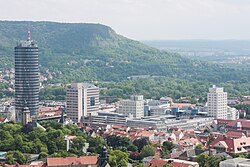- Leipzig is the heart of the Central German Metropolitan Region and is nicknamed "Hypezig".
- Halle (Saale), biggest city in Saxony-Anhalt and seat of the Martin Luther University of Halle-Wittenberg.
- View over Chemnitz. The city is among the top ten German cities in terms of economic growth rate.
- Gera market
- View over downtown Wittenberg in Wittenberg district
- Leipzig City Tunnel forms the centerpiece of an extensive S-Bahn network serving 1.2 million people in the Leipzig/Halle metropolitan area.
Central German Metropolitan Region | |
|---|---|
 Leipzig is the largest city in metropolitan area | |
 Location of Central German Metropolitan Region in Germany | |
| Country | |
| States | |
| Area | |
| • Metro | 9,718 km2 (3,752 sq mi) |
| Population | |
| • Metro | 2,411,051 |
| • Metro density | 250/km2 (640/sq mi) |
| GDP | |
| • Metro | €102.532 billion (2021) |
| Time zone | UTC+1 (CET) |
| Website | http://www.mitteldeutschland.com/en/page/wirtschaft |
The Central German Metropolitan Region (German : Metropolregion Mitteldeutschland) is one of the officially established metropolitan regions in Germany. It is centered on the major cities of Leipzig and Halle, extending over Central German parts of the states of Saxony-Anhalt, Thuringia and Saxony. The Central German metropolitan region is the only one located entirely within the former East Germany. The "region" is not actually a metropolitan area in the geographic sense of the word as an agglomeration of nearby urban areas, rather it is a registered association, [3] the Europäische Metropolregion Mitteldeutschland e.V. whose membership is composed of towns, cities, municipalities, and companies, colleges and chambers of commerce in the central German geographic area, whose representatives vote upon new members. [4] For example, Jena joined the Metropolitan Region in 2009. [5] The registered association owns the management company Metropolregion Mitteldeutschland Management GmbH. [6] As such it forms a planning and marketing [7] framework for the region while retaining the legal independence of its members.[ citation needed ]






